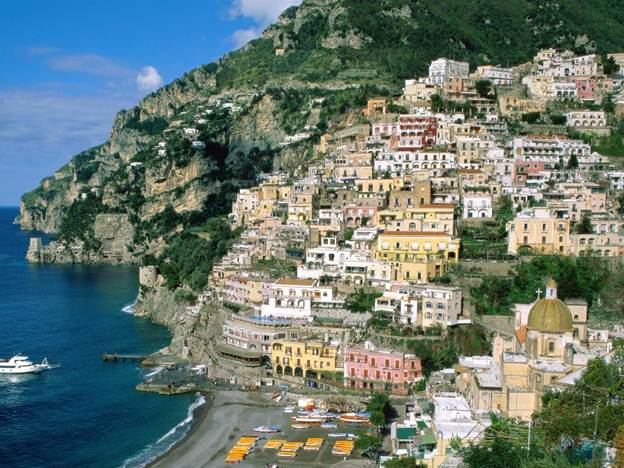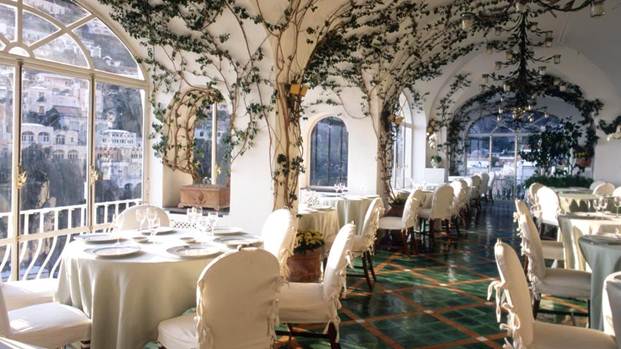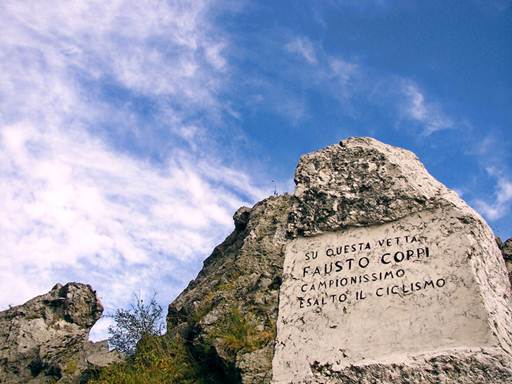Having sworn off Italy’s Amalfi Coast
for being overcrowded, Emily Wright is won over by the glorious old-world charm
of the Excelsior Vittoria – and the classical education she gets as she walks
the Path of the Gods…

At a time when so many hotels are battling
to out-cool each other, hiring cutting-edge designers and investing in bizarre
in-room technologies, it’s a great relief to stay in a hotel that remains
faithful to its 19th-century origins.
Italy’s gorgeous Bay of Naples is no
stranger to great hotels, but the Excelsior Vittoria has the pedigree of being
the first in Sorrento, and Italy’s oldest family-owned hotel (it’s been run by
the Fiorentino family since it opened in 1834). It is also, in some ways, the
most central and most low-key. You’ll miss it if you don’t look. It’s tucked
away down a long drive lined with heavy-fruited citrus trees, just off
Sorrento’s main square, Piazza Torquato Tasso, when everyone gathers for
aperitif hour and people-watching.
Inside, the hotel’s interior is a gift to
any period costume drama; you half expect Helena Bonham-Carter to appear in
bustling skirts from behind a pillar. There are large, elegant salons with silk
all hangings, damask-covered furniture and vast windows with stained panels
overlooking a balustrade terrace and, beyond, a glistening sea and, of course,
the looming specter of Vesuvius. Plaster cherubs smile down from the ceilings,
and heavy gilt frames surround the ageing, foxed-glass mirrors, where 19th-century
princesses would have once admired themselves by candlelight. Look up, and
you’ll see original ceiling frescoes, especially in the magnificent ballroom,
where breakfast is served every morning. The reception is packed with sepia
photographs of luminaries rolling up in vintage classic cars, and Sofia Loren
in her voluptuous prime, pouting on the balcony. Hip hotels, eat your heart
out.

Of course, The Excelsior has had to keep up
with the times. During its 172-year history, the hotel has built two extra
wings, including a bizarre chalet-like building created to please Austrian
royalty, who holidayed here in the 19th-century. The hotel’s biggest
selling point meanwhile is its location, perched overlooking the perfectly
curved inlet of the Bay of Naples, one of the world’s most famous stretches of
coastline, and justly so. Thanks to rigid planning laws, the area has kept
developers at bay, so the coast hasn’t been ruined by identikit villa building.
Towns like Positano look much as they did 70 years ago, when writers like John
Steinbeck came here to hang out in small bars with local fishermen. Even so,
things have changed. In summer, ten thousand tourists can descend on a town
that was built to accommodate four thousand. In high season, the charms of the
area, with its slow-moving, traffic-choked coastal road, can start to fade
fast.
Which is why you need to get your walking
boots on and head for the hills? The Germans and Swiss discovered the delights
of walking the mountains that loom over this coastline years ago; the Brits
have recently started to realize what they’ve been missing.

One of the best-known walks is the Path of
the Gods, which you can do at a brisk pace in about two hours, or three with a
picnic break built in. The walk starts in the hilltop town of Agerola, and
follows a mountain path – scarily narrow in places with an unfenced sheer drop.
On the way, you’ll enjoy magnificent panoramic views of the sea and the
villages below, and can see sights immortalized by Homer in The Odyssey
(the Bay of Naples is where Odysseus heard the sirens singing to him).
That myth gives you some idea of the area’s
sensually beautiful landscapes. Our guide was Elisabeth Sommer, an Austrian who
married a local man and is an expert on the area’s flora, fauna, and local
traditions. As you walk, Sommer will point out flowers, and help you navigate
your way around the herds of goats that crowd the path. The sound of their
bells chiming is the only thing you will hear on this walk; other than that,
it’s just the whirr of the wind, and the faint purr of the sea below.
The path finishes at a village called
Nocelle. From here, you can jump on a bus down to Positano, or brave the
1,700-step stairway that takes you all the way down. This is certainly pretty,
and will keep you out of the sin as it winds its way through cool wooded areas,
affording tantalizing glimpses of Positano as you approach it, but beware:
going downstairs seems easy, but this number of steps takes its toll on your
calves. Be sure to rest on the way, and stretch properly at the end. Unbelievably,
the nimble-footed locals still climb this stairway and some still use donkeys
to carry shopping and goods with them – it’s quicker than taking the long,
circuitous route by road.

Positano is as lovely as you’ve been told.
Small, white and labyrinthine, with a fine Baroque church and a sandy beach, it
recalls island villages in Greece. It’s packed with boutique art galleries and
shops selling linen aromatic soaps, liqueurs and home-made ice-creams. At Da
Carmine you can have a simple pair of summer sandals, with diamante or stone
adornments, made-to-order in about ten minutes by a cobbler who sits outside in
the street. Positano may be one of the area’s most popular tourist towns, but
its independent shops and artisans still give it an authentic, small-town feel.

Exhausted, we headed back to the hotel.
There, Vincenzo Galano, head chef at the Excelsior Vittoria, a born-and-bred
Sorrento man, had rustled up plenty of sophisticated dishes involving special
cuts of beef and fish, but there was plenty of simple food, too. It’s rare you
taste pasta, cheese and vegetables that are a world away from what you are used
to. Parmigianino, a dish that is normally a bland, stringy, tasteless mess in
most international restaurants was here a heavenly aromatic mound of
melt-in-the-mouth flavor. I’d also recommend the cuts of this fragile pizza,
flavored with delicate herbs and tomato so fresh it feels like a pick-me-up.

The last time I came to this part of Italy,
I swore I would never go back – it was too crowded. But I’ve changed my mind;
it’s too lovely to ignore. Go early or late in the season before (May or after
mid-September). Spend a bit extra on a hotel like the Excelsior Vittoria that
is spacious, quite, civilized, and has its own private grounds (and pool) where
you can escape the hordes. And last, but not least, give Sommer a ring and go
walking. There are many other walks you can do aside from the Path of the Gods
– all of them offering a peaceful and private way of experience Italy’s most
magical coast.
For information on walking The Path of the
Gods, contact Enjoy Positano on enjoypositano.com